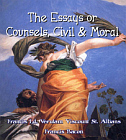
Two Babylons, The

Description
or The Papal Worship Proved to be the Worship of Nimrod and His Wife
By Rev. Alexander Hislop
Excerpt:  First published as a pamphlet in 1853
First published as a pamphlet in 1853
greatly expanded in 1858
"And upon her forehead was a name written, MYSTERY, BABYLON THE GREAT, THE MOTHER OF HARLOTS AND ABOMINATIONS OF THE EARTH."--Revelation 17:5
With sixty-one woodcut illustrations from Nineveh, Babylon, Egypt, Pompeii, etc. Objects of Worship; Festivals; Doctrine and Discipline; Rites and Ceremonies; Religious Orders; The Two Developments Historically and Prophetically Considered.
Contents
Introduction
Chapter I : Distinctive Character of the Two Systems
Chapter II : Objects of Worship
Section II. The Mother and Child, and the Original of the Child
Sub-Section II. The Child in Egypt
Sub-Section III. The Child in Greece
Sub-Seciton IV. The Death of the Child
Sub-Section V. The Deification of the Child
Section II. Easter
Section III. The Nativity of St. John
Section IV. The Feast of the Assumption
Section II. Justification by Works
Section III. The Sacrifice of the Mass
Section IV. Extreme Unction
Section V. Purgatory and Prayers for the Dead
Section II. Relic Worship
Section III. The Clothing and Crowning of Images
Section IV. The Rosary and the Worship of the Sacred Heart
Section V. Lamps and Wax-Candles
Section VI. The Sign of the Cross
Section II. Priests, Monks, and Nuns
Section II. The Beast from the Sea
Section III. The Beast from the Earth
Section IV. The Image of the Beast
Section V. The Name of the Beast, the Number of His Name--the Invisible Head of the Papacy
Chapter VII: Section I
The Great Red Dragon
This formidable enemy of the truth is particularly described in Revelation 12:3--"And there appeared another wonder in heaven, a great red dragon." It is admitted on all hands that this is the first grand enemy that in Gospel times assaulted the Christian Church. If the terms in which it is described, and the deeds attributed to it, are considered, it will be found that there is a great analogy between it and the first enemy of all that appeared against the ancient Church of God soon after the Flood. The term dragon, according to the associations currently connected with it, is somewhat apt to mislead the reader, by recalling to his mind the fabulous dragons of the Dark Ages, equipped with wings. At the time this Divine description was given, the term dragon had no such meaning among either profane or sacred writers. "The dragon of the Greeks," says Pausanias, "was only a large snake"; and the context shows that this is the very case here; for what in the third verse is called a "dragon," in the fourteenth is simply described as a "serpent." Then the word rendered "Red" properly means "Fiery"; so that the "Red Dragon" signifies the "Fiery Serpent" or "Serpent of Fire." Exactly so does it appear to have been in the first form of idolatry that, under the patronage of Nimrod, appeared in the ancient world. The "Serpent of Fire" in the plains of Shinar seems to have been the grand object of worship. There is the strongest evidence that apostacy among the sons of Noah began in fire-worship, and that in connection with the symbol of the serpent.
We have seen already, on different occasions, that fire was worshipped as the enlightener and the purifier. Now, it was thus at the very beginning; for Nimrod is singled out by the voice of antiquity as commencing this fire-worship. The identity of Nimrod and Ninus has already been proved; and under the name of Ninus, also, he is represented as originating the same practice. In a fragment of Apollodorus it is said that "Ninus taught the Assyrians to worship fire." The sun, as the great source of light and heat, was worshipped under the name of Baal. Now, the fact that the sun, under that name, was worshipped in the earliest ages of the world, shows the audacious character of these first beginnings of apostacy. Men have spoken as if the worship of the sun and of the heavenly bodies was a very excusable thing, into which the human race might very readily and very innocently fall. But how stands the fact? According to the primitive language of mankind, the sun was called "Shemesh"--that is, "the Servant"--that name, no doubt, being divinely given, to keep the world in mind of the great truth that, however glorious was the orb of day, it was, after all, the appointed Minister of the bounty of the great unseen Creator to His creatures upon earth. Men knew this, and yet with the full knowledge of it, they put the servant in the place of the Master; and called the sun Baal--that is, the Lord--and worshipped him accordingly. What a meaning, then, in the saying of Paul, that, "when they knew God, they glorified Him not as God"; but "changed the truth of God into a lie, and worshipped and served the creature more than the Creator, who is God over all, blessed for ever." The beginning, then, of sun-worship, and of the worship of the host of heaven, was a sin against the light--a presumptuous, heaven-daring sin. As the sun in the heavens was the great object of worship, so fire was worshipped as its earthly representative. To this primeval fire-worship Vitruvius alludes when he says that "men were first formed into states and communities by meeting around fires." And this is exactly in conformity with what we have already seen in regard to Phoroneus, whom we have identified with Nimrod, that while he was said to be the "inventor of fire," he was also regarded as the first that "gathered mankind into communities."
End Excerpt
8x10.5", 330 pages, softbound













